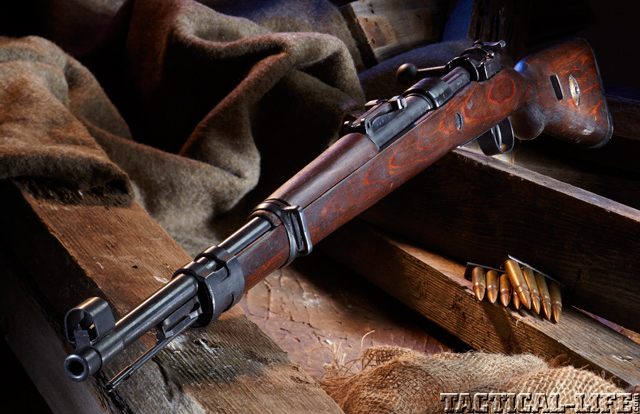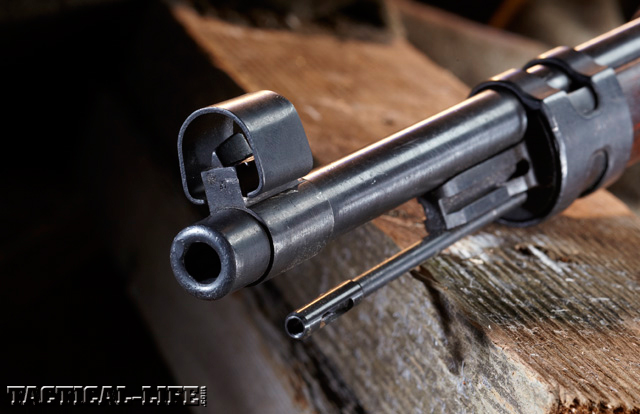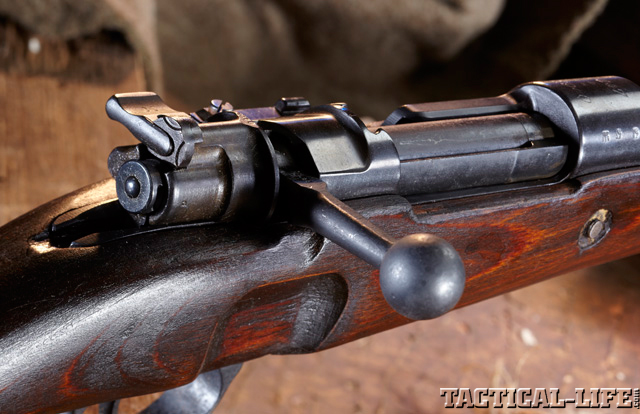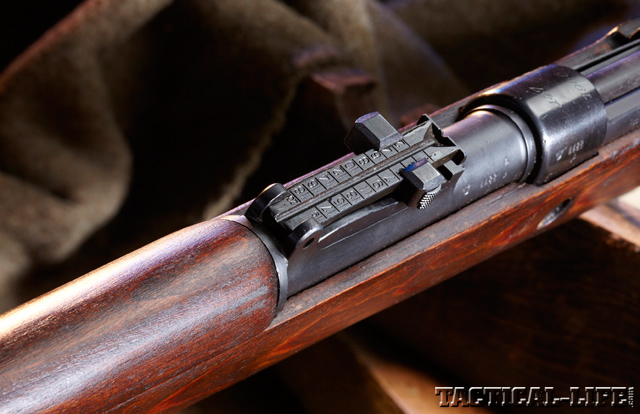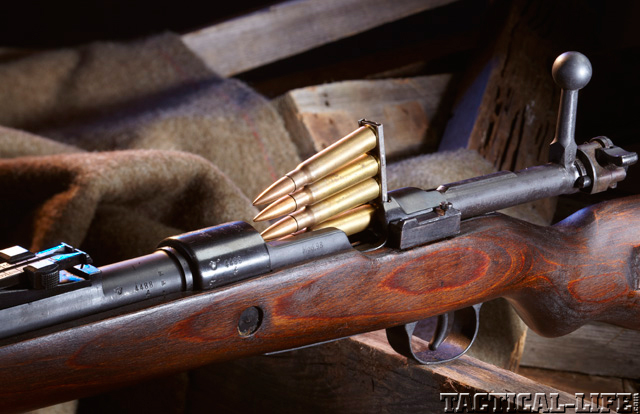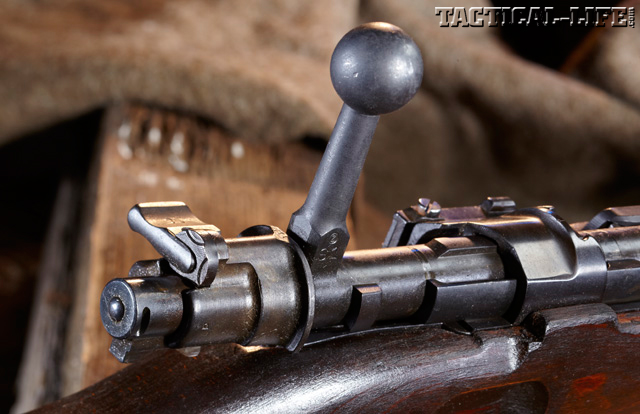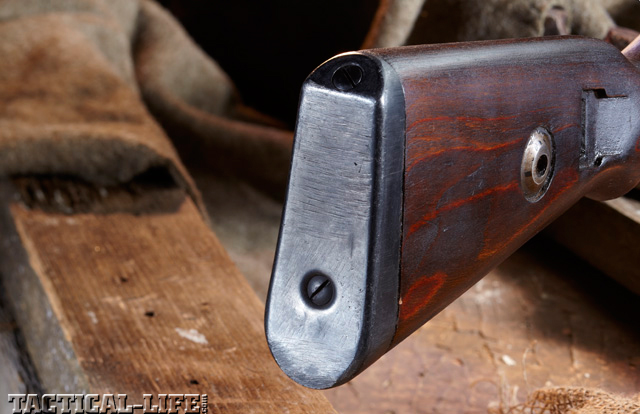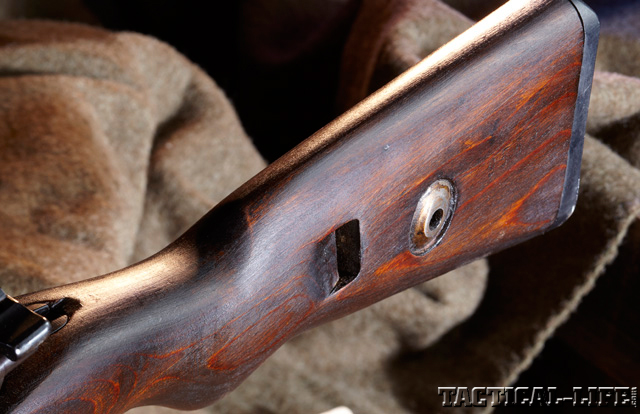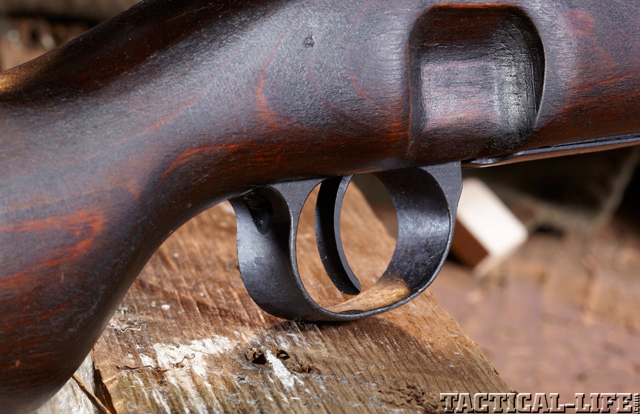The last stockpiles of surplus Karabiner 98 Kurz (K98k) rifles are drying up, even as demand from collectors, hunters and shooters continues to rise. K98ks are legendary bolt-action rifles—the last in a long line of military Model 98s. They provide a rich field for collecting, a hands-on connection with history and an opportunity for enjoyable shooting. The K98k was the fruit of a tree with deep roots. And one look at the Mauser Model 98 will tell you that Peter Paul Mauser was a belt-and-suspenders man.
Mauser’s classic bolt-action rifle is a portrait of defensive engineering at its best. He incorporated multiple redundant safety features that protect the shooter: In addition to the two fixed lugs at the front of the bolt, a third safety lug at the root of the bolt handle served as a backup. A gas escape port and a flared striker shield protected the shooter’s eyes from hot propellant gasses in the event of a case-head failure. The Model 98’s three-position mechanical safety set the standard for fail-safe design and ease of use. Another quality that defined Mausers in general, and the Model 98s in particular, was their rapid reloading. In addition to the clip slot in the rear receiver bridge, a semi-circular cutout in the right-hand receiver wall for the firer’s thumb helped ensure that the rounds were deeply and positively seated in the magazine. Also, its huge claw extractor controlled the cartridge from the moment it was presented by the follower until the spent case was kicked out by the ejector. Built for maximum durability and reliability, the Model 98 came to be appreciated by sportsmen and military shooters alike.
Eye of the Storm
During the Great War, Imperial Germany’s standard infantry rifle, the Gewehr 98, and cavalry carbine, the Karabiner 98AZ, were based on the Model 98. The reasons for the defeat of Imperial Germany and her Axis allies are almost too numerous to list, but the lack of good service rifles and carbines was not one of them. In the muddy trenches of the Western Front, the Gewehr 98 and Karabiner 98AZ proved reliable under the worst conditions imaginable. After the war, both guns remained the standard service arms of the Reichsheer. The armament restrictions of the Treaty of Versailles and the economic deprivation of the Weimar era stalled any further development of new service rifles. Scarce resources were funneled into secret programs that were a higher priority—particularly planes and to tanks. But in 1934, one year after Adolf Hitler and the Nazi Party came into power, a comprehensive rearmament program that included updating the Model 98 began in earnest. The German military, now renamed the Wehrmacht, was, of course, very interested in a semi-automatic service rifle, but they concluded that development would take several years, at a time when they felt they desperately needed a new rifle.
Advertisement — Continue Reading Below
What the Wehrmacht wanted was a universal service rifle rather than different models for the infantry, cavalry, and artillery and support troops. The result was the K98k (the “k” stands for “kurz,” which means “short” in German). The new rifle incorporated all of the hard lessons learned through bitter defeat. For example, the 29-inch barrel of its predecessor, the Gewehr 98, was a product of military doctrine that was dated and backward even before the Model 98 was developed. At the end of the 19th century, every army wanted to make the most of the ballistic potential of the then-new smokeless powder. Generals compared a platoon of infantry to a mobile artillery battery whose firepower was most effective as long-range volley fire. Enemy troops, softened up by this rain of lead, would then be driven from the field by mass bayonet charges. When you envision a battlefield like that, issuing your troops a short barrel and bayonet would be seen as an act of contempt.
Universal Carbine
Of course, like so many other myths, this myopic military doctrine died a brutal death in Flanders fields. It turned out that a shorter 24-inch barrel was more than enough to maximize the range of the 8x57mm Mauser cartridge and was much easier to handle in tight quarters. The turned-down bolt handle offered a shorter bolt throw and, thus, a faster rate of fire. Dispensing with finger grooves made for a sleeker, lighter, more compact forend. Compared to its predecessor, the K98k was compact, lightweight, well balanced and easy to carry and shoot. Arguably, it was the developmental pinnacle of the Mauser 98 as a service rifle but also a dead-end. Over the course of the next decade, the Germans discovered countless ways to streamline the K98k’s manufacture, but they were never able to significantly improve its performance. However, two small improvements were introduced: a 2-inch-longer cleaning rod that allowed its seat to be moved deeper, making the stock less likely to crack; and the addition of a front sight hood with horizontal grooves cut in the front sight base, which helped anchor the spring steel hood.
Once the German firearms industry got behind it, production ramped up quickly at Mauser Oberndorf (then Mauser Borsigwalde), at Sauer und Sohne and at Gustloffwerke. After the annexation of Austria, Steyr was brought online. When Czechoslovakia was absorbed into the Reich, its arsenals in Bystrica and Brno (which the Germans called “Bruenn”) were put to work making K98ks as well. The Germans refrained from making small arms in occupied countries, for fear their products would fall into the hands of guerrillas and saboteurs. Factories that made 98 Mausers before the war, such as FN in Belgium, made just parts and not complete guns. As the war dragged on and battlefield losses increased, German manufacturers did everything they could to fill in the gap and speed up production. Walnut stocks gave way to laminated birch and beech. Milled furniture such as the flat buttplate and U-shaped forend cap were replaced by stamped steel components. In addition, fit and finish was allowed to deteriorate in the name of rapid production. Prewar guns were usually highly polished and richly blued, but wartime components were often littered with tooling marks and coated with a dull blue or even a flat phosphate finish.
Advertisement — Continue Reading Below
Millions of K98ks were made during the war. Despite desperate efforts to replace the bolt-action K98k with the semi-automatic Gewehr 43 and the revolutionary select-fire Sturmgewehr 44, it remained the standard service rifle until the last days of WWII.
Spoils Of War
Chief among the numerous allied countries that took home K98ks, parts and machinery as war reparations was Yugoslavia. After the war, it also built thousands of K98ks, which the Yugoslavians dubbed the “M98.” M98s include both reconditioned wartime K98ks and rifles built from leftover parts. Norway and Israel also used re-barreled K98ks for a time: The Norwegians opted for the .30-06 Springfield, while the Israelis chose the 7.62mm NATO. All three of these countries scrubbed most of the swastika-laden wartime proof marks during their re-build processes.
The size, scope, duration and not to mention the ferocity of the savage war on the Eastern Front was difficult to comprehend. A large part of the story remains untold, so it should be no surprise that most K98ks wound up in Soviet hands at the end of the war. Their intent was to put them away: The K98ks were to be brought out in an emergency or supplied to client states or communist insurgent movements in the Third World. Accordingly, the rifles were prepared for long-term storage. Unserviceable rifles were rebuilt, so guns were reassembled without regard to their manufacturers. As a result, most of the Russian-capture K98ks are a hodgepodge of early- and late-war components. And the front sight hood, cleaning rod and floorplate capture screws often went astray during the overhauls. Additionally, it appears that there was no effort to keep bolts with their original receivers, even in cases where the guns were serviceable. (The Soviets often electro-penciled the bolt with the serial number of the receiver to which it was mated.) The K98ks were preserved in true Soviet style: crudely but effectively. The guns were reblued, but the Soviets had no qualms about rebluing over rusted metal. And the stocks were coated with shellac that was allowed to spill over metal parts. The result was not attractive, but it certainly kept the guns from rusting and rotting away.
Advertisement — Continue Reading Below
I have heard the argument comparing Russian-capture K98ks to U.S. small arms like Garands and M1 Carbines, which almost always went through numerous postwar rebuilds. I would say that is certainly true, but U.S. surplus arms, even those returned by our Cold War allies, were generally rebuilt to a high standard. Also, for collectors of U.S. small arms, all-original guns are very scarce while all-matching German small arms are relatively more numerous. If you have the money and expertise, you might as well hold out for them. That said, Russian-capture K98ks certainly have their place in the collector’s market. They are great shooters and an excellent way to learn more about original markings and production idiosyncrasies firsthand, rather than from pictures in books or internet message boards. Underneath all of that heavy bluing and shellac are stories ready to be told and lessons ready to be learned.
GERMAN EXPATRIATE
Century International Arms sent me a Russian-capture K98k for testing, so I had a chance to try out one out for myself. The receiver ring bears the “147” code for Sauer and a production date of 1940. (Most but not all of the “Waffenamt” proof markings have had their swastikas peened out, but they haven’t been scrubbed away entirely.) As Russian-capture K98ks go, this is a real gem. The stock is free of shellac, and the bluing is relatively dark but competently applied and not at all inconsistent (as I’ve seen on some late-war guns). Another welcome surprise was the presence of a front sight hood, cleaning rod and capture screws. One oddity was the straight bolt handle: it may have come from a WWI-era Gewehr 98. Given the heavy pressure on the German war industry, the Germans were relentless recyclers, and some wartime-produced K98ks have bolts from WWI-era rifles and carbines. But my gut is telling me that this gun’s bolt was replaced by the Soviets because, firstly, that was their habit and, secondly, the bolt lacks any of the WWII-era stamps, strikeouts or restrike markings that show up on German-recycled parts.
My K98k’s bore was bright, and the rifling was strong. At the range it proved to be a good shooter. I had a chance to shoot it with Romanian and Yugoslavian surplus, as well as some new-production 8mm Mauser from Hornady. With the latter, it held just over 2 inches at 100 yards, which is probably the best I can do with open-notch iron sights. The two-stage trigger was one of the best I have ever experienced on a K98k. Take-up was long (like they all are), but it broke cleanly at just over 4 pounds of pull. Recoil was stout, but the wide footprint of the buttplate and the ergonomic design of the stock kept it manageable. Unlike a straight-stocked ’03 Springfield or a Mosin-Nagant, it didn’t tax my endurance.
Advertisement — Continue Reading Below
Code Breakers
Between 1934 and 1945, the German military’s system of receiver codes changed three times. During the first three years of production, receiver rings were marked with an “S” followed by a two- or three-digit number assigned to the manufacturer, as well as a letter that referred to the year of manufacture. In 1937, both the “S” prefix and the year suffix were dropped. Instead of a coded letter for the year, the Germans stamped all four digits of the production year below the manufacturer’s numeric code. Finally, during 1940 the German military dropped numeric codes in favor of a system based on letters, and the year of production was denoted only by the last two digits. During the last two years of the war, many manufacturers stamped only a single digit on the receiver, such as “4” or “5,” to represent the year of production.
Accessories, particularly bayonets, are a big part of collecting K98ks. Like the K98k itself, the bayonet was shortened in an effort to make it handier and more useful. It has a 10-inch drop-forged steel blade with a fuller (blood groove) and a spear point. Grips may be wood or Bakelite. Apart from a decline in quality (more pronounced tooling marks, reduced polishing, duller finish), the construction and design of the K98k bayonet remained unchanged until the end of the war. The bayonets were not made by the rifle manufacturers but by manufacturers who specialized in cutlery. The bayonets were serial numbered in a manner identical to the rifles (four digits with a letter suffix), but they were not paired with a rifle that carried the same serial number.
The K98k was also issued a tobacco-can cleaning kit made of stamped sheet steel and containing a pull-through chain, an oil bottle and a bore brush. German troops were supposed to carry it in a haversack suspended by their service belt, but it was small enough to fit in most jacket or trouser pockets.
Advertisement — Continue Reading Below
Into the Field
The K98k is a legendary bolt-action rifle with an interesting history that provides a rich field for collecting. Ten different manufacturers and countless wartime production changes helped create a wide variety of markings and unusual variants to chase down. Not to mention sniper rifles and Mauser variants the Germans produced from captured rifles and machinery like the 98/40 and G 33/40. The guns are starting to dry up, but Century Arms and a handful of other importers still have some in stock, so if you are interested in these guns, the time to buy is now. For more information, contact Century Arms at 800-527-1252, centuryarms.com.
